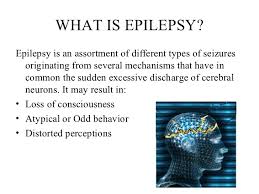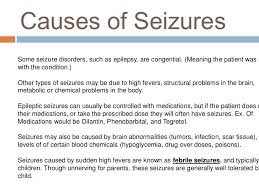Epilepsy
Most people with epilepsy are otherwise healthy; as long as it is controlled like most other diseases. A seizure is a physical manifestation of paroxysmal and abnormal electrical firing of neurons in the brain. Think of it as numerous voltage (hyperexcitability of neurons) going throughout the brain meaning brain waves going in all directions with the brain saying its too much activity causing the brain to go into a seizure.
When the seizure occurs there is a decrease in oxygen since the brain isn’t capable to send messages during the seizure. If the seizure continues to repeat one right after another the person is in status epilepticus and if the seizures doesn’t stop the person can lead to a neuronal death; like John Travolta’s son who died of this.
The term seizure disorder may refer to any number of conditions that result in such a paroxysmal electrical discharge. These conditons could be metabolic or structural in nature. Epilepsy is the term for those who have a second seizure that occurs spontaneously and without preceding metabolic or structural cause for the occurrence. Epilepsy is a chronic disorder that requires antiepileptic drug therapy; usually thorough out life.
Etiology of Epilepsy is generally a sign of underlying pathology involving the brain. It may be the first sign of nervous system disease (ex. Brain tumor), or it may be a sign of a systemic or metabolic derangement.
Metabolic and Systemic Causes of Seizures:
a.) Electrolyte Imbalance=Acidosis, heavy metal poisoning, Hypocalcemia, Hypocapnea, Hypoglycemia, Hypoxia, Sodium-Potassium imbalance, Systemic diseases (liver, renal failure, etc…) Toxemia of pregnancy, and water intoxication.
b.) Infections like meningitis, encephalitis, brain abcess.
c.) Withdrawal of sedative-hypnotic drugs=Alcohol, Antiepileptic drugs, Barbiturates, Benzodiazepines.
d.) Iatrogenic drug overdose=Theopylline, Penicillin.
Other causes of epilepsy can be Trauma, Heredity.
Structural causes of epilepsy:
Head trauma/Degenerative Disease like Alzheimer’s or Creutfeldz-Jacob or Huntington’s Chorea or Multiple Sclerosis or Pick’s Disease. There is also tumors or genetic disease or Stroke or Infections or Febrile seizures.
Types of seizures
I-Partial seizures (seizures beginning local)
1-simple partial seizures-(the person is conscious and not impaired). With motor symptoms, autonomic symptoms and even psychic symptoms.
2.)-Complex partial seizures-(the person is with impairment of consciousness)
II-Generalized seizures-(bilaterally symmetrical and without local onset).
3.) Tonic clonic seizures – Grand Mal
Diagnosis
The history of the person is the most valuable component of the workup of that individual with possible epilepsy.
The routine diagnostic tooling to see if someone has this disease is a EEG which is the major diagnostic test. EEG takes short samples of brain wave activity with 26 wires to the scalp recording amplified brain waves from the superficial regions of the brain by means of scalp electrodes.
Laboratory studies are done to rule out various causes for seizures. Routine blood and urine studies are often done for baseline information. Electrolytes and blood chemistries will be evaluated to identify possible metabolic causes for seizures.
Neuropsychological testing may be done in the evaluation of persons presenting with seizures. The purpose of neuropsychological testing is to determine if there is brain dysfunction and to determine if the pattern of change in brain function is indicative of a destructive lesion. Neuropsychological testing involves evaluation of cognitive functions and personality and emotional traits.
Medical Management
The major medical treatment for epilepsy is antiepileptic medications. Epileptic seizures can be controlled in 50 to 95% of cases with this form of treatment depending on seizure type and compliance of the individual taking their medications.
Those taking medications for epilepsy know if a single first line drug is not effective a second first lin drug is added but the noneffective drug is tapered off while the second first line drug is given. Know during this time frame there is a risk for seizure activity so practice safety (ex. do not drive).
In some cases there is surgery: those with intractable seizures is the epileptic focus may be possible. In some cases partial complex seizures are the common seizure treated by surgery. The focus of this seizure type has often been found in the anterior temporal and inferior frontal regions of the brain cortex.
There are other treatments as well.
Care during a Seizure what do we do and what is the major concerns for the individual seizing:
The care of a person in a seizure should focus primarily on maintaining a safe environment. The seizure that has greatest risk for causing injury and even fatality is the generalized tonic/clonic (grand mal), although there is a potential for injury with any seizure that involves alteration of consciousness.
The 2 major goals for care during a seizure are protection from injury and prevention of aspiration. The person’s head should be cradled if on the floor to prevent banging of the head. At no time should the person be restraint when having a seizure. The person should be turned to their side to allow the tongue to fall away from the airway and allow drainage of the excessive saliva that accumulates to drain out of the mouth during the seizure. You should stay with the person till the seizure stops and note the behavior mentally and physically the person exhibits while having the seizure and how long it lasts. Immediately call 911 (especially if this is the first seizure the person ever had) or call the neurologist of the individual to have the him or her be evaluated ASAP.


